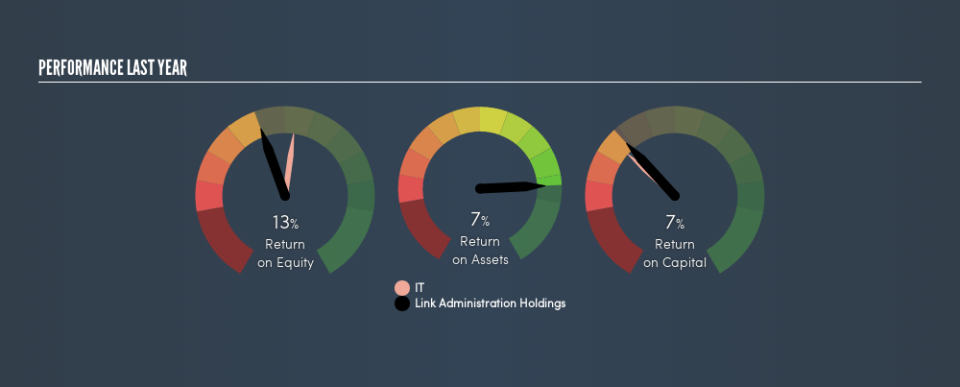Should You Worry About Link Administration Holdings Limited’s (ASX:LNK) ROCE?

Today we are going to look at Link Administration Holdings Limited (ASX:LNK) to see whether it might be an attractive investment prospect. To be precise, we’ll consider its Return On Capital Employed (ROCE), as that will inform our view of the quality of the business.
First up, we’ll look at what ROCE is and how we calculate it. Next, we’ll compare it to others in its industry. Last but not least, we’ll look at what impact its current liabilities have on its ROCE.
Understanding Return On Capital Employed (ROCE)
ROCE measures the ‘return’ (pre-tax profit) a company generates from capital employed in its business. All else being equal, a better business will have a higher ROCE. Ultimately, it is a useful but imperfect metric. Renowned investment researcher Michael Mauboussin has suggested that a high ROCE can indicate that ‘one dollar invested in the company generates value of more than one dollar’.
How Do You Calculate Return On Capital Employed?
Analysts use this formula to calculate return on capital employed:
Return on Capital Employed = Earnings Before Interest and Tax (EBIT) ÷ (Total Assets – Current Liabilities)
Or for Link Administration Holdings:
0.069 = AU$221m ÷ (AU$3.8b – AU$634m) (Based on the trailing twelve months to December 2018.)
So, Link Administration Holdings has an ROCE of 6.9%.
See our latest analysis for Link Administration Holdings
Is Link Administration Holdings’s ROCE Good?
When making comparisons between similar businesses, investors may find ROCE useful. We can see Link Administration Holdings’s ROCE is meaningfully below the IT industry average of 13%. This could be seen as a negative, as it suggests some competitors may be employing their capital more efficiently. Aside from the industry comparison, Link Administration Holdings’s ROCE is mediocre in absolute terms, considering the risk of investing in stocks versus the safety of a bank account. Readers may find more attractive investment prospects elsewhere.
Remember that this metric is backwards looking – it shows what has happened in the past, and does not accurately predict the future. Companies in cyclical industries can be difficult to understand using ROCE, as returns typically look high during boom times, and low during busts. ROCE is only a point-in-time measure. Since the future is so important for investors, you should check out our free report on analyst forecasts for Link Administration Holdings.
How Link Administration Holdings’s Current Liabilities Impact Its ROCE
Current liabilities are short term bills and invoices that need to be paid in 12 months or less. Due to the way ROCE is calculated, a high level of current liabilities makes a company look as though it has less capital employed, and thus can (sometimes unfairly) boost the ROCE. To counter this, investors can check if a company has high current liabilities relative to total assets.
Link Administration Holdings has total liabilities of AU$634m and total assets of AU$3.8b. As a result, its current liabilities are equal to approximately 17% of its total assets. This very reasonable level of current liabilities would not boost the ROCE by much.
What We Can Learn From Link Administration Holdings’s ROCE
With that in mind, we’re not overly impressed with Link Administration Holdings’s ROCE, so it may not be the most appealing prospect. But note: Link Administration Holdings may not be the best stock to buy. So take a peek at this free list of interesting companies with strong recent earnings growth (and a P/E ratio below 20).
I will like Link Administration Holdings better if I see some big insider buys. While we wait, check out this free list of growing companies with considerable, recent, insider buying.
We aim to bring you long-term focused research analysis driven by fundamental data. Note that our analysis may not factor in the latest price-sensitive company announcements or qualitative material.
If you spot an error that warrants correction, please contact the editor at editorial-team@simplywallst.com. This article by Simply Wall St is general in nature. It does not constitute a recommendation to buy or sell any stock, and does not take account of your objectives, or your financial situation. Simply Wall St has no position in the stocks mentioned. Thank you for reading.

 Yahoo Finance
Yahoo Finance 
